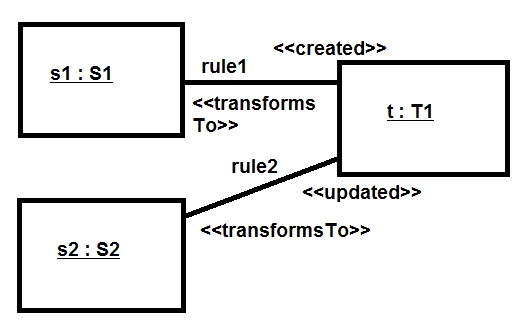Entity Merging/Structure Abstraction
This is a modularisation pattern which
specialises Phased Construction.
Summary
One target model
entity type
is updated using
data from two or more different source model entity types.
Separate rules
should be used to define the updates
from separate sources.
Application conditions
This pattern is
used when a target entity type
amalgamates
data from several different source entities. The target entity type will
appear in the succedent of two
or more rules and each rule will create
or update instances of it.
Solution
Define the separate updates as
distinct rules,
creating the target instance in
the first rule, and using some means of object
lookup to locate this instance for update by subsequent
rules.

In cases where a closely semantically
related group of source elements are
mapped to a single target element,
using a multiple matching rule, separate
rules are not suitable. This could be
termed the Structure Abstraction
pattern.
Benefits
This pattern can be used to improve the decomposition
of the specification, simplifying individual rules.
It should be checked that rules Ri and
Rj which may update the
same instance
do not semantically
interfere with each other:
they either update entirely separate
and independent
sets of features of the instance, or they
update shared features (which must
be set-valued association ends), in a
consistent and order-independent
way (by both
adding elements to the
association ends).
This enables the rules to be
implemented by successive phases.
The mapping of identity attributes from source objects
to target objects can be non-injective, but in such a case
successive updates to the same target object from
different source objects
must also be non-interfering.
Applications and examples
The pattern
is applicable to the same categories of
transformations as Phased Construction,
but it is particularly relevant to
abstraction transformations or to
model-merging transformations, which
combine two separate models into
a single model.
An alternative form of the UML to
relational database transformation could
take account of inheritance in the
source model, and only creates relational
tables for root classes in the
source model inheritance
hierarchy, the data of
subclasses is then merged into these
tables.
Tables are created (for root classes
only) by one rule and then
updated by another, so this
transformation conforms to the pattern.
Related patterns
The pattern is a special case of
Phased Construction.
This pattern is referred to as
the global source to
local target
type of transformation in
(Cuadrado et al, 2009). The node abstraction pattern in
(Iacob et al, 2008) corresponds to
a case of Structure Abstraction, as
does flattening.
The reverse transformation of an
entity merging is an entity splitting
transformation.
In order to look up already existing
t : T1 objects, to update them with
additional data, some mechanism such
as trace-based lookup or the
Object
Indexing pattern
must be used.
The pattern can be extended
to the Model Merging
architectural pattern
in cases where the
input model can be split into smaller
models, together with a separation of
the transformation into target
creation and elaboration sub-transformations.
(Cuadrado et al., 2009) J. Cuadrado, J. Molina,
Modularisation of model transformations
through a phasing mechanism, Software Systems
Modelling, Vol. 8, No. 3, pp. 325--345, 2009.
(Iacob et al, 2008) M. E. Iacob, M. W. A. Steen,
L. Heerink,
Reusable model transformation patterns,
Enterprise Distributed Object Computing Conference Workshops,
2008, pp. 1--10, doi:10.1109/EDOCW.2008.51.

